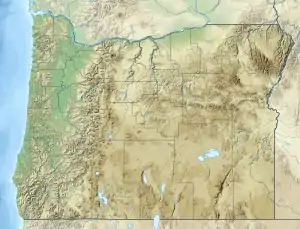Pudding River
The Pudding River is a 62-mile (100 km) tributary of the Molalla River in the U.S. state of Oregon. Its drainage basin covers 528 square miles (1,368 km2). Among its tributaries are Silver Creek, Butte Creek, Abiqua Creek, and the Little Pudding River.
| Pudding River | |
|---|---|
 Pudding River near Aurora | |
 Location of the mouth of the Pudding River in Oregon | |
| Etymology | From Riviere au Boudin, given by French fur trappers in the early 19th-century to commemorate a blood pudding made from elk they shot near the river[1] |
| Location | |
| Country | United States |
| State | Oregon |
| County | Marion, Clackamas |
| Physical characteristics | |
| Source | Waldo Hills |
| • location | east of Salem, Marion County |
| • coordinates | 44°53′51″N 122°44′42″W[2] |
| • elevation | 953 ft (290 m)[3] |
| Mouth | Molalla River |
• location | near Canby, Clackamas County |
• coordinates | 45°17′54″N 122°43′07″W[2] |
• elevation | 62 ft (19 m)[2] |
| Length | 62 mi (100 km)[4][5] |
| Basin size | 528 sq mi (1,370 km2)[6] |
| Discharge | |
| • location | Aurora, 8.11 miles (13.05 km) from the mouth[7] |
| • average | 1,237 cu ft/s (35.0 m3/s)[7] |
| • minimum | 3.5 cu ft/s (0.099 m3/s) |
| • maximum | 43,700 cu ft/s (1,240 m3/s) |
Historically, the Pudding River flowed directly into the Willamette River, and aerial photos dating back to 1936 provide evidence of the Willamette River's confluence with the Pudding River main stem channel.[8] Currently, it flows directly into the Molalla River near River Mile 1 before joining the Willamette River. Anadromous and resident salmonids use the Lower Pudding River main stem and key tributaries that support the basin's ecosystems.
Geology
About 24 million years ago at the end of the Oligocene, Oregon had started to look how it is today and the Willamette Bay finally became the Willamette Valley by drying up and being raised above sea level, after assuming a shape much like today's Puget Sound.[9]
Course
The Pudding River Basin's complex of headwater creeks originates from the western edge of the Cascade Mountains along a snowpack-limited rigdeline (i.e. no glaciers are present) that forms a critical linkage from the Mount Hood National Forest and Table Rock Wilderness to Silver Falls State Park and the rolling Waldo Hills east of Salem. Peak ridgeline elevations vary from 3,750 to 4,250 feet (1,140 to 1,300 m). After emerging from the Cascade Mountain foothills of the Panther Rock Ridge and its unique forested upper-elevation wetlands and lakes, the key tributaries of the watershed like ecologically-important Butte Creek converge near Woodburn into the meandering Pudding River. Passing through and within the Pudding River Valley, the numerous subwatersheds of the Pudding Basin represent a vital part of fertile agricultural lands of the Lower Willamette Valley sub-basin. Two forks of the Pudding join between the cities of Silverton and Mt. Angel, at 45.036368°N 122.833275°W, as the river continues its course northward where it receives Abiqua Creek from the right at about 2 miles (3.2 km) northwest of Silverton. North of Mt. Angel, Butte Creek, which comes down from the Cascade Range foothills past Scotts Mills, empties into the Pudding River at 45.160768°N 122.773569°W. The river continues northward past the town of Aurora. For most of its course, Butte Creek and the Lower Pudding River mainstem defines the boundary between Marion and Clackamas Counties.
The Pudding River flows into the Molalla River, at 45.282375°N 122.716856°W, just before the Molalla joins the Willamette River in a floodplain that is part of the Molalla River State Park.
Fishing
The upper river offers catch-and-release fishing for wild trout, while the lower river has bass and panfish. Although the Pudding River is not stocked with hatchery fish, coastal cutthroat trout and rainbow trout enter the upper main stem from Drift, Butte, Silver, and Abiqua creeks. Fishing is restricted to artificial flies and lures and is not allowed for winter-run steelhead (anadromous rainbow trout) that spawn in the tributaries. The extreme lower reaches of the river are navigable by boat when the stream flow is sufficient, sometimes as late as June.[10]
References
- McArthur, Lewis A.; McArthur, Lewis L. (2003) [1928]. Oregon Geographic Names (7th ed.). Portland, Oregon: Oregon Historical Society Press. pp. 788–89. ISBN 0-87595-277-1.
- "Pudding River". Geographic Names Information System (GNIS). United States Geological Survey. November 28, 1980. Retrieved August 10, 2010.
- Source elevation derived from Google Earth search using GNIS source coordinates.
- United States Geological Survey. "United States Geological Survey Topographic Map". TopoQuest. The relevant map quadrants, Canby, Woodburn, Silverton, and Stayton NE, Oregon, include river-mile (RM) markers to RM 59 (river kilometer 95). The remaining 3 miles (5 km) is an estimate based on map scale and ruler.
- Oregon Atlas & Gazetteer (Map) (1991 ed.). DeLorme Mapping. § 54, 60. ISBN 0-89933-235-8.
- Pudding River Watershed Council; Adolfson Associates; Alsea Geospatial. "Pudding River Watershed Assessment, 2006". Oregon Department of Fish and Wildlife. Retrieved October 14, 2011.
- "Water-Data Report 2007: 14202000 Pudding River at Aurora, OR" (pdf). United States Geological Survey. 2007. Retrieved November 11, 2008.
- Kurt D. Carpenter; Christiana R. Czuba; Christopher S. Magirl; Mathieu D. Marineau; Steve Sobieszczyk; Jonathan A. Czuba; Mackenzie K. Keith (2012). "Geomorphic Setting, Aquatic Habitat, and Water-Quality Conditions of the Molalla River, Oregon, 2009-10". United States Geological Survey. Retrieved 2012-11-01.
- Bishop, Ellen Morris (2003). In Search of Ancient Oregon: A Geological and Natural History (1st ed.). Portland, Oregon: Timber Press. p. 125. ISBN 0-88192-590-X.
- Sheehan, Madelynne Diness (2005). Fishing in Oregon: The Complete Oregon Fishing Guide (10th ed.). Scappoose, Oregon: Flying Pencil Publications. p. 163. ISBN 0-916473-15-5.